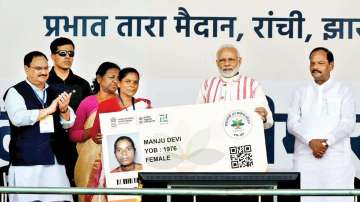Seventeen per cent of households in the National Capital of Delhi, homes to the most deprived and poor families, are eligible to be covered under the Ayushman Bharat- National Health Protection Scheme (AB-NHPS), which had been rechristened as the Pradhan Mantri Jan Arogya Yojana (PMJAY).
The data, based on calculations from the Socio-Economic Caste Census (SECC) 2011, further highlights that a total of 5.88 lakh families in the National Capital Territory (NCT) could benefit from Ayushman Bharat, billed as the world’s largest healthcare scheme.
Further, the total potential individual beneficiaries from Ayushman Bharat number more than 26 lakh, of which almost 23 lakh (22,96,806) reside in urban neighbourhoods.
Approximately 55 per cent of the potential beneficiaries are male, the rest being women.
Delhi had a total of 3,435,999 households, as per the last Census published in 2011.
Out of 34.3 lakh homes in the Capital, the total number of rural households were 79,574. The Census had put the number of urban households at 33.56 lakh. Approximately 1.6 crore persons dwelled in these homes, as per the last Census.
Rolled out the Prime Minister himself on September 23, 2018, in Ranchi, Ayushman Bharat identifies itself as an “entitlement-based scheme,” which covers poor and vulnerable families based on deprivation and occupational criteria.
The scheme provides health coverage up to Rs. 5 lakh per family per year for secondary and tertiary hospitalisation to around 10.74 crore poor and vulnerable families (approx. 50 crore beneficiaries), as per government records.
Delhi, which has been ruled by Aam Aadmi Party (AAP) after its stunning victory in the 2015 assembly elections, is among a handful of opposition-ruled states which has refused to implement Ayushman Bharat. The Delhi government has argued that its own healthcare scheme, under the umbrella of Delhi Arogya Kosh (DAK) is better than the central scheme as it provides coverage to more families and has no cap on the insurance amount that can be drawn.
However, the Delhi government was until last year struggling to empanel private hospitals as part of DAK, in contrast to Ayushman Bharat’s list of empanelled hospitals, which has been growing at a much faster rate.
On the other hand, the Centre has argued that the “portable” nature of PMJAY, in terms of the beneficiaries being allowed to avail cashless benefits from any public or private empanelled hospital across the country is another of its salient features.
The decision of the Delhi government to not be part of the PMJAY has been a talking point in the lead-up to the assembly vote on Feb 8, with the Prime Minister and the Union Home Minister Amit Shah having flayed the Delhi chief minister Arvind Kejriwal for “depriving” the residents of Delhi of the benefits of Ayushman Bharat.
